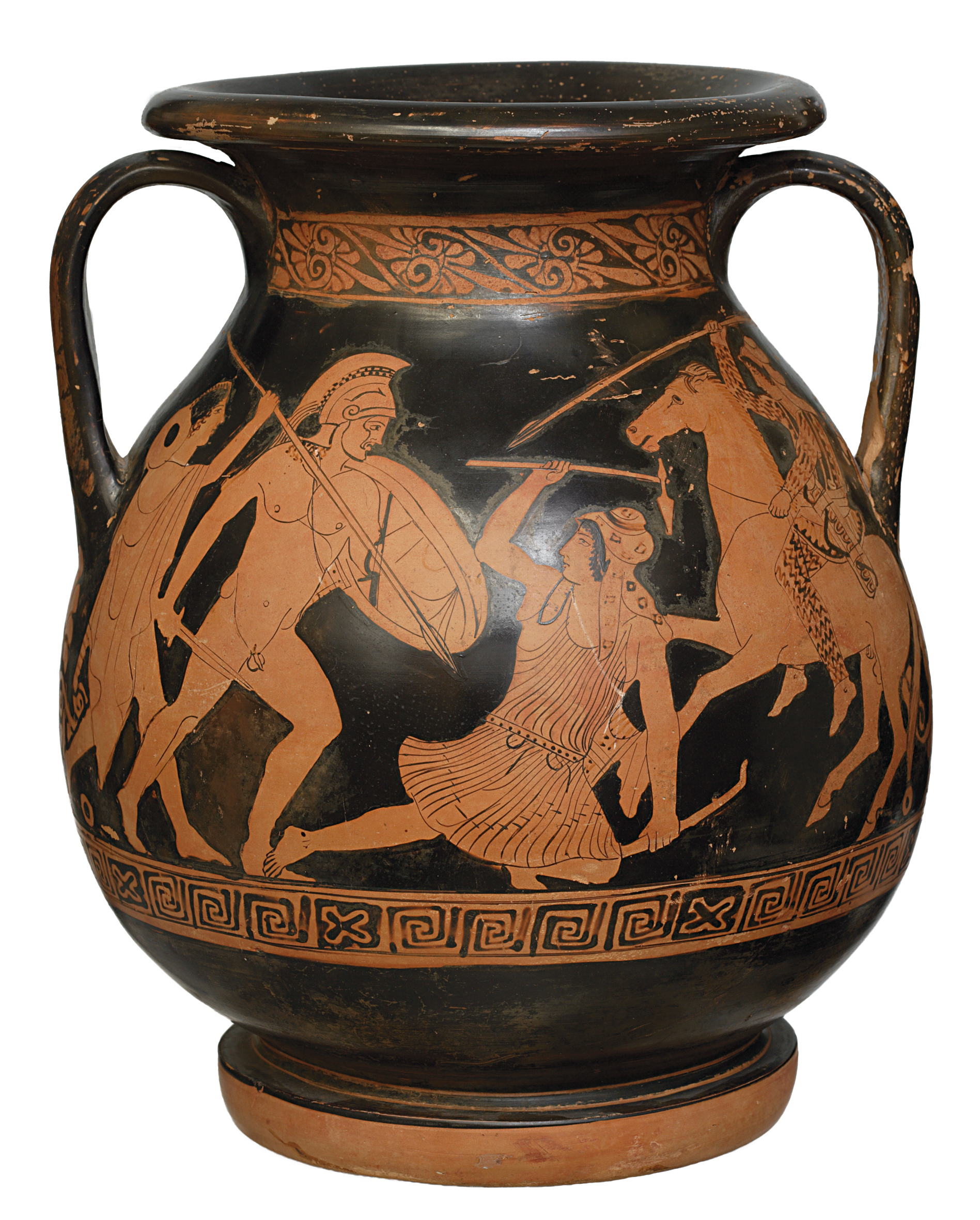Exhibit of the month
Female valor [1]: Amazons, the mythical warrior women
Attic red-figure pelike
Attributed to the Akragas Painter
National Archaeological Museum
Vase Collection, inv. no. Α 12492
Provenance: Unknown
Dimensions: Ht. 0.34m.
Date: Ca. 440 BC.
Display: Room 55, showcase 114
On the vase’s obverse a naked warrior holding a sword, his companion at his side, attacks a female figure, who has already fallen to the ground trying to defend herself with her battle-axe. A mounted female figure rushes from the right to her aid, ready to attack the naked warrior with her spear.
The sex, dress and armor of the women taking part in this conflict leave no doubt as to their identification with the Amazons, the mythical female warriors. The ancient Greeks considered the Amazons a paradoxical society of women, who, having adopted male roles, were exclusively engaged in war and hunt[2].
Tradition has it that the most illustrious mythical heroes confronted and vanquished them: Βellerophon[3] in Lycia, Herakles[4] in the Black Sea, Theseus[5] outside the walls of Athens, and Achilles at Troy, killing their queen Penthesilea[6].
Their placement by the Greek worldview in the periphery of the civilized world is the reason why after the mid 6th century BC[7] they frequently appear in ancient Greek art with elements of barbaric dress and armor (Strabo, 11, 504), chiefly borrowed from the iconography of the Scythians and, later, the Persians. On the National Archaeological Museum pelike the two Amazons wear the Persian tiara, a soft cap with flaps, while the mounted Amazon is dressed in the Persian manner, with tight anaxyrides, and a garment with close-fitting sleeves topped by a chitoniskos. Their weaponry comprises the Scythian-Persian battle-axe, called the sagaris, while their legendary skills in archery and horse riding is alluded to by their depiction in the type of a foot- and mounted archer, quiver hanging at the side.
The subject of the Amazonomachy became very popular and was depicted on emblematic monuments, such as, e.g., on the shield of the Athena Parthenos, the western metopes of the Parthenon, the west pediment of the temple of Asklepios at Epidauros, and the western metopes of the new temple of Hera at the Argive Heraion. Some scholars have recognised in this conflict the mythological archetype of the rivalry of the sexes, with the victory of the Greeks emphatically highlighting male superiority. However, for most researchers it is a clear allusion to the faith of the Greeks in their military and spiritual supremacy over the barbarians, clearly demonstrated in their great victory against the Persians.
Dr. Maria Tolia-Christakou
[1] Lysias, Funeral Oration for the Men Who Supported the Corinthians (4,6-8) “ἐνομίζοντο δὲ διὰ τὴν εὐψυχίαν μᾶλλον ἄνδρες ἢ διὰ τὴν φύσιν γυναῖκες” (They [the Amazons] were accounted as men for their high courage, rather than as women for their sex).
[2] In the literary sources the Amazons were the daughters of Ares and the Naiad Harmonia, who lived south of the Black Sea, in the valley of the river Thermodon, or to the north and northwest, in Thracian territory or in regions neighboring Scythia.
[3] The myth of the Corinthian hero Bellerophon is mentioned for the first time in Homer’s Iliad (6, 150-211), narrated to Diomedes by Glaukos, the hero’s grandson. His fight against the Amazons was the third task assigned to Bellerophon by Iobates, the king of Lycia, in order to exterminate him by order of the hero’s father-in-law Proetus, king of Argos. Bellerophon, aided by his winged horse Pegasos, had already slain the Chimaera – a monster with the head and body of a lion, a goat-head on its back and the tail of a snake – and had vanquished the Solymeans, a people inhabiting Asia Minor. Vase painting usually depicts Bellerophon either alone riding Pegasos or killing the Chimaera astride his winged horse.
[4] Herakles’ ninth labor by Eurystheus’ command was to bring to the king the belt of Hippolyte, queen of the Amazons. The hero sailed together with his companions to Themiskyra, capital city of the Amazons, where he managed to acquire the belt after defeating them.
[5] According to Pausanias (Ι, 2, 1) and Philochoros (frgt. 49), Theseus had accompanied Herakles in his expedition against the Amazons at Themiskyra. There he captured Antiope, sister of the Amazon queen Hippolyte, inducing the wrath of the Amazons, who, in revenge, besieged Athens. The hero, together with the Athenians, defeated them in a great battle beneath the Acropolis.
[6] The murder of the Amazon queen Penthesilea by Achilles is described in the Aithiopis, an epic attributed to Arktinos of Miletus. According to the myth, Penthesilea originated from Thrace and was the daughter of Ares and the Amazon Otrere. After Hector’s death she rushed to Troy to fight on the Trojan side. She excelled in battle, slaying many Achaeans, among which Podarkes, brother of Protesilaos. She was subsequently killed by Achilles, who, dazzled by her beauty, fell in love with her and thus allowed her burial by the Trojans.
[7] In early Attic vase painting and until ca. 530/520 BC, the Amazons are depicted in the heavy armor of Greek hoplites, cuirass on top of a chitoniskos, crested helmet, greaves, round shield, spear and sword, as also described in epic tradition. They are thus distinguished from their Greek opponents only by the white color used by vase painters for rendering the female flesh.
Suggested Bibliography
Roscher, ML (1884-1890) 267-280 λ. Amazonen (H. Steuding).
D. von Bothmer, Amazons in Greek Αrt (Oxford 1957).
LIMC I (1981) 586-653 λ. Amazones (P. Devambez – A Kaufmann-Samaras).
H. A. Shapiro, Amazons, Thracians, Scythians, GrRomByzSt 24, 1983, 105-114.
E. C. Keuls, The Rein of the Phallus. Sexual Politics in Ancient Athens (New York 1985) 44-47.
C. Schubert – A. Weiß (επιμ.), Amazonen zwischen Griechen und Skythen. Gegenbilder in Mythos und Geschichte (Berlin 2013).
R. Sturm, Amazonen in der antiken Vasenmalerei. Die Bedeutung des Bildmotivs der kriegerischen Frau in der alten Töpferkunst (Hamburg 2017).


